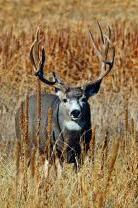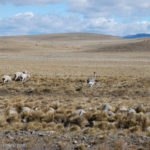Wyoming’s mule deer migrate some 150 miles every year.
 If you think of wildebeest in the Serengeti when you think of large mammal migrations, start thinking a little closer to home. Scientists have discovered that the longest known migration of mule deer—an incredible 150-mile journey between winter range and summer range—occurs every year in western Wyoming. The deer move from low-elevation winter range in the Red Desert near Interstate 80 to the high mountains surrounding the Hoback Basin in northwestern Wyoming. They spend some four months on their journey, negotiating sand dunes, lake and river crossings, multiple highways, and more than a hundred fences.
If you think of wildebeest in the Serengeti when you think of large mammal migrations, start thinking a little closer to home. Scientists have discovered that the longest known migration of mule deer—an incredible 150-mile journey between winter range and summer range—occurs every year in western Wyoming. The deer move from low-elevation winter range in the Red Desert near Interstate 80 to the high mountains surrounding the Hoback Basin in northwestern Wyoming. They spend some four months on their journey, negotiating sand dunes, lake and river crossings, multiple highways, and more than a hundred fences.
Biologists discovered the phenomenon when they placed GPS collars on twelve deer in the Red Desert in 2011 and followed their movements through spring 2013.
Increasing levels of energy and housing development, recreation, and traffic on busy highways poses major threats to mule deer movements, as well as to similar migration routes used by pronghorn antelope. Findings from the study will help conservationists plan projects that will keep these migration routes open.
“Migration corridors and habitats where big-game animals rest and forage during migration are critical pieces in a complex habitat puzzle that is key to the health of populations of mule deer and other big-game animals,” said Ed Arnett of the Theodore Roosevelt Conservation Partnership.
“If we do not safeguard all the pieces of that puzzle, including important habitats associated with migration, big-game populations likely will decline and impact both our outdoor traditions and our hunting-based Western economy.”
Learn more at www.migrationinitiative.org.










